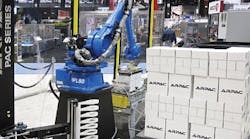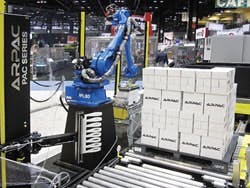"Many builders and integrators just stop once a machine is installed and tested, but we tend to look back at past projects, and use what we learn to anticipate future needs," says Tim Reder, Arpac's strategic account manager. "We also do a lot of aftermarket support, field changes and upgrades, and this leads to users that bought a stretch wrapper coming back and asking for a tray wrapper. That's how we work together. We'll start integrating a project, but we'll also bring in paint and coating guys, beverage guys or other experts in their industries. This lets us handle projects from beginning to end by doing what amounts to proactive troubleshooting."
Established in 1971, Arpac has 30,000 installations worldwide. Its packaging systems have been successfully installed in many industries, including food and beverage, printing and publishing, pharmaceutical, personal care, building supplies, automotive, material handling and a variety of other industrial and consumer products. Arpac's product line includes shrink wrappers, shrink bundlers, tray formers, case formers, tray packers, case packers, shrink tunnels, pallet stretch wrappers and stretch hooding systems.
"The world has changed," says Paul Moore, Arpac's strategic accounts director. "Five years ago, we were selling individual machines, but now we're selling integrated systems. So, instead of just having the best price on a machine that day, we're in very long-term relationships in which end users are entrusting us with critical parts of their operations and businesses. Beyond being a trusted advisor to a customer's business, we're often directly responsible for their whole packaging line and its successful performance."
"We have three primary ways to communicate," Reder explains. "We can use a client's virtual private network (VPN) to reach into their machines, but sometimes they don't want to allow too much outside access to their systems, and so they can reach out to us via our web-based portal and give us live or stored data and status reports on their machines. The third way is we can both log on to our dedicated, cloud-based service, where we can interact to maintain and optimize the machines and packaging lines."
Ironically, besides building and integrating machines, Arpac has even been pulled into taking on some tasks usually performed by its own suppliers as it seeks to serve its customers. For instance, intelligent sensors on its equipment are typically implemented to help monitor process control and optimize machine uptime. However, these sensors multiplied as many machines and lines grew more complex, and so Arpac recently developed its Human Machine Intelligence Quotient (HMiQ) software and related components to help coordinate all this incoming information. The company already uses Rockwell Automation's PanelView Plus interfaces on its devices, and these have displayed Microsoft CE software for the past several years, including on-screen guides, manuals, PDFs and even videos. HMiQ takes these capabilities and information sharing even further.
"A key element of HMiQ is that we made it a lot friendlier for operators to use, and it allows even less-trained staff to see what they need to do," Moore explains. "However, HMiQ also enables onboard tracking, and can send alerts to operators when they need to perform specific tasks, as well as provide videos at the machine to assist operators. It's also especially helpful in managing some of our customized machines and packaging lines.
"For example, some customers recently asked us to develop a special, high-speed, shrink-film machine, but it needs to have about $30,000 of intelligent sensors to keep its process running within specifications, and HMiQ's smart screens help it keep operating successfully. Users can really see the value of these added sensors on the shrink-film machine because HMiQ shows how they're checking film thickness, air pressure feedback, electrical current, vibration and other factors, which helps keep them all within the right parameters. Besides monitoring regular operations, the sensors and HMiQ can also be configured to detect and monitor trends, and provide predictive alerts before a fault occurs. This can also help our customers produce better packages, achieve greater uptime, and reduce their lifecycle costs."







